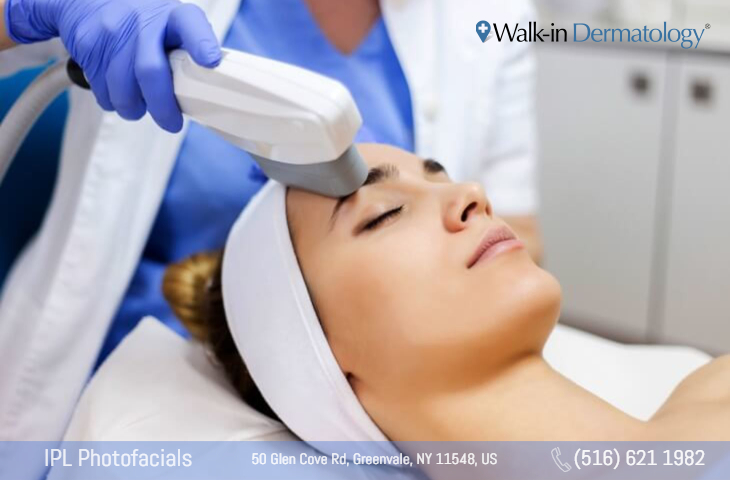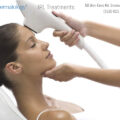Tues: 8:30am - 3:00pm
Wed: 12:00pm - 6:00pm
Thurs: 8:30am - 3:00pm
Fri: Closed
Sat: 8:30am - 12:30pm
Sun: Closed
Greenvale, NY 11548
How Long Does IPL Take to Heal?


Healing after an IPL treatment varies with the patient although in most cases takes less than a week and as little as 2 to 3 days.
IPL stands for Intense Pulsed Light. Dermatologists use this non-surgical therapy to remove blemishes and imperfections in the skin, or in severe cases make them less noticeable. IPL can stop the clock on signs of aging skin, while reducing wrinkles and fine lines. The procedure is often referred to as a “photofacial” treatment and can be performed anywhere on the body.
With IPL, the therapy light converts to heat that targets deeper layers of skin, breaking up the pigmentation and blood cells that cause skin discoloration. As the treated area heals, your skin produces healthy elastin and collagen, restoring the skin to a natural condition, giving you a more youthful appearance.
One advantage of IPL over other light therapies, such as laser treatments, is IPL works on a range of light wavelengths and so it can be used for different skin treatments. Laser light works on a single, narrow wavelength so it cannot be used to treat as many different skin conditions as IPL.
You can maximize your results by following your aesthetician’s or dermatologist’s pre-procedure instructions. Most importantly, stop using any type of product containing Vitamin A on the face for at least 60 days before your IPL therapy appointment. This includes retinoic acid, glycolic acid, tretinoin (Retin-A), Accutane, and alpha-hydroxy acids.
There may be mild discomfort during IPL treatment, but most patients tolerate removal of dilated blood vessels or age spots, freckles and fine lines very easily. The first treatment may feel tingly. Patients often say follow-up treatments become even more comfortable as their skin begins to clear.
Afterward, you might feel a slight sensation of sunburn that should go away in a matter of hours and no more than a day or two, at most.
Healing times after IPL vary both with individual patients and the condition being treated.
For veins, the skin looks slightly redder for 2 to 5 days after treatment.
Freckles and age spots after treatment generally turn darker for 3 to 7 days before they begin to fade. Crusting may occur, and can last up to 10 days. Crusting is the result of pigmentation rising to the skin surface as a result of IPL therapy and gradually flaking off. Usually 3 to 5 treatments are required over a period of months to clear age spots.
Ask your dermatologist if it’s okay to use makeup right after the treatment. It may not be a concern if applied and removed gently, although your dermatologist may suggest avoiding makeup until 48 hours post-treatment, depending on your skin condition.
In rare cases, patients may experience skin bruising. This usually heals in 1 to 2 weeks.
It’s important to talk to a dermatologist before receiving any type of intense light therapy. Your dermatologist will diagnose your skin condition and be able to give you the best recommendation for treatment. A dermatologist can also work with you to identify the underlying causes of a skin condition so you can take steps to prevent it from getting worse or coming back. For instance, applying a quality sunscreen and wearing a hat when you spend time outdoors will make a dramatic difference in the health of your skin while reducing the appearance of darkened pigmentation.
What are IPL Treatments Like?
At your dermatologist’s office you will be shown to the IPL treatment room. You’ll wear special glasses or eye pads to protect your eyes during treatment. A cool gel is applied to the skin being treated. The IPL wand is then gently applied to your skin. Because of your eye protection you won’t see but may feel the pulsing light, sometimes described as a light tingle or slight sting. Therapy times depend on the skin condition being treated, but typically last between 30 and 90 minutes.
After your treatment, the gel is removed from your skin, which is then cleaned with a warm cloth. This is followed by an application of moisturizer containing sunscreen.
If you experience any swelling or discomfort, you may receive a cold pack to hold on the skin for a few minutes.
Once your dermatologist gives the go-ahead, you can apply makeup, in most cases right after therapy.
Follow all post-care instructions given to you by your dermatologist. These directions are designed to help your skin heal as quickly as possible while producing the best results from IPL treatment.
To achieve lasting results, expect to visit the dermatologist’s office for 3 to 5 IPL treatments. Annual maintenance treatments may also be necessary. Treatments are usually scheduled a month apart. This is because your skin cells turn over once about every 30 days, giving your skin a chance to recover fully before the next IPL treatment.
Possible side effects from IPL treatment:
- Skin redness, tenderness or swelling 48 hours to a week post-treatment
- Blisters and burns (extremely rare)
- Scabbing (this is typical of brown spots, which rise to the surface of your skin, crust over and gradually flake off)
What to do to speed up healing after IPL therapy:
- Use mild cleansers and moisturizers daily on your skin.
- Apply a sunscreen with a minimum of 30 SPF. This protects your skin from UVB and UVA rays.
- Cleanse your skin twice a day with warm water
- Perform a microdermabrasion facial 2 to 3 weeks after treatment with IPL. This protects and hydrates your skin while removing dead skin cells.
- Add stem cell serum to your skin regimen to boost collagen repair, and give your skin a smooth and healthy appearance
What not to do after IPL therapy:
- No hot showers for 48 hours.
- Avoid taking aspirin, Ibuprofen, consuming alcohol, heavy exertion and activities which may cause flushing for 2 days after treatment.
- Avoid harsh topical products such as retinols and glycolic acid products for one week after treatment.
- Avoid direct sunlight on the treated area and use a sunscreen with SPF 30 or greater for 4 to 6 weeks after treatment.
- No swimming, especially in pools with chemicals such as chlorine.
- No hot tubs.
- Avoid activities that cause excessive perspiration.
- Do not pick at or remove any loosening or peeling skin.
- No electrolysis, facial waxing or depilatories (hair removal products) for 14 days after a treatment.
Getting the Best IPL Treatment
You don’t have to look far for excellent dermatology services – including IPL therapy – and now there’s no waiting.
In many parts of New York and throughout the country, patients often wait weeks before they can see a board-certified dermatologist and receive a diagnosis.
That’s no longer necessary.
At Walk-in Dermatology, patients can see a board-certified dermatologist seven days a week. Our dermatologists will evaluate your skin and answer all your questions. If light therapy seems like the right solution for your skin condition, our office will set up IPL treatments convenient for your schedule.
No more waiting days or even weeks to receive light therapy treatments. If you are seeking a non-surgical way to revitalize your appearance and treat sun damage, wrinkles and fine lines, rosacea, enlarged pores, scars and much more, Walk-in Dermatology is open and ready to serve you. We are here to help you achieve healthy, radiant skin that positively glows.
Read more: What Can I Expect After a Photofacial?








